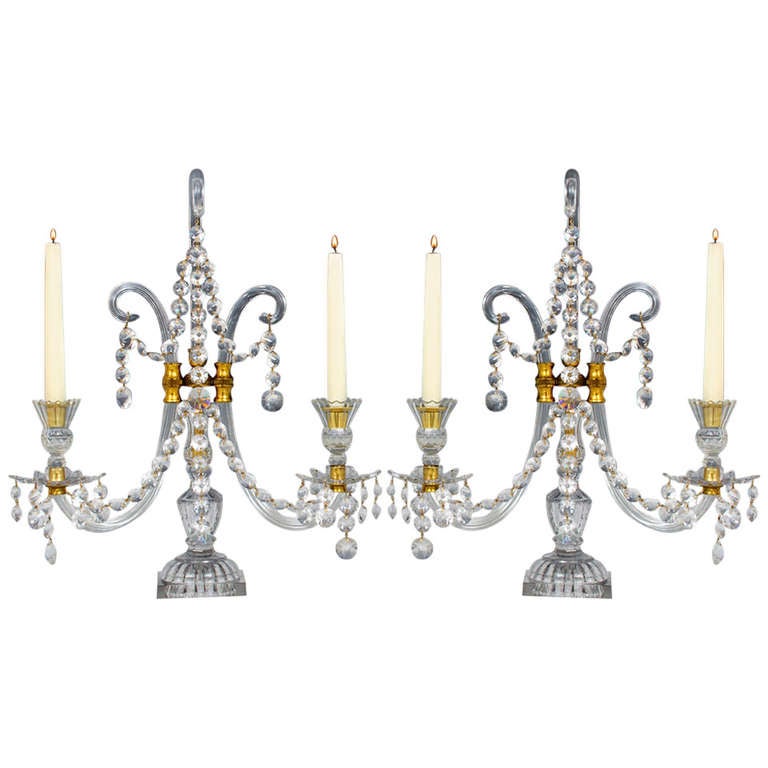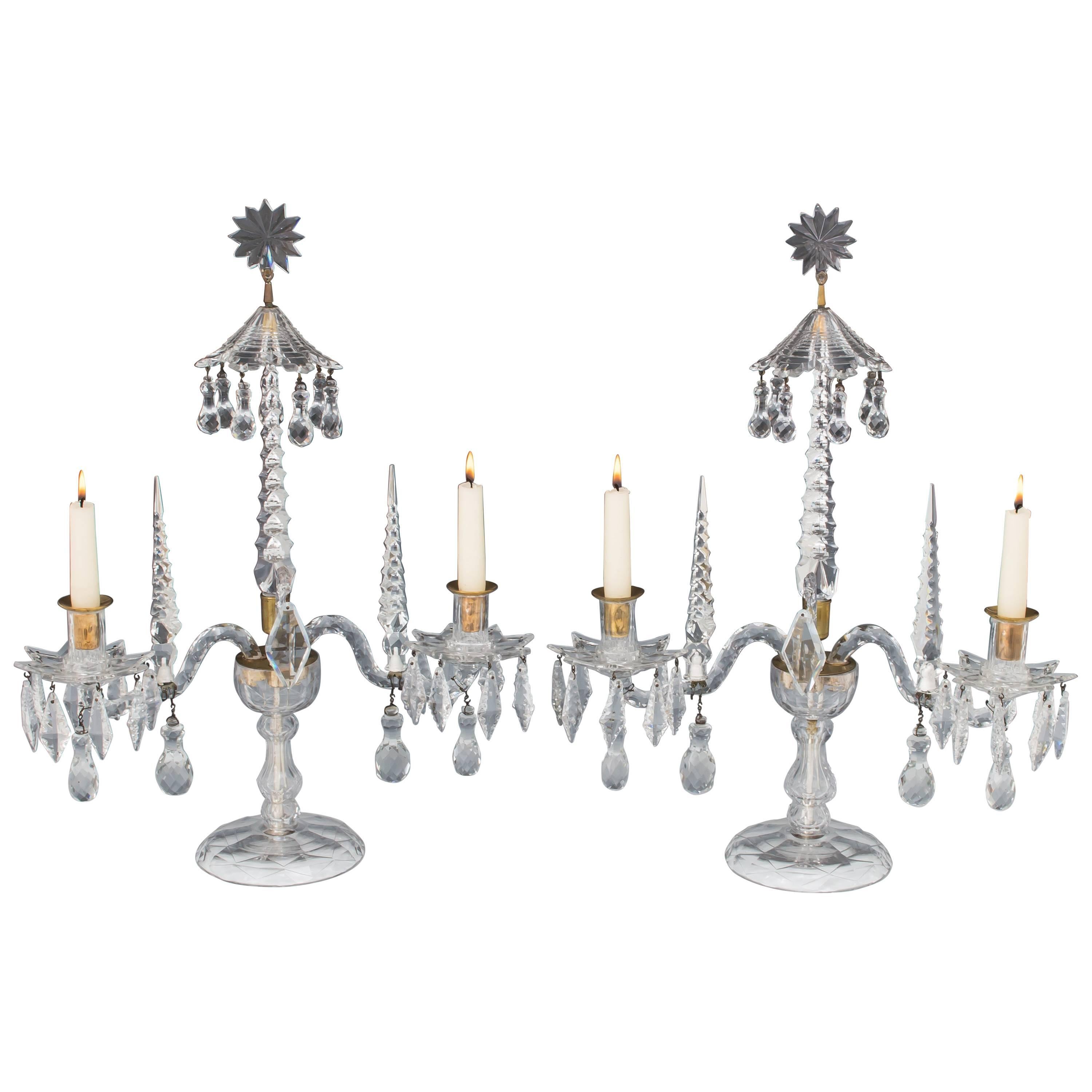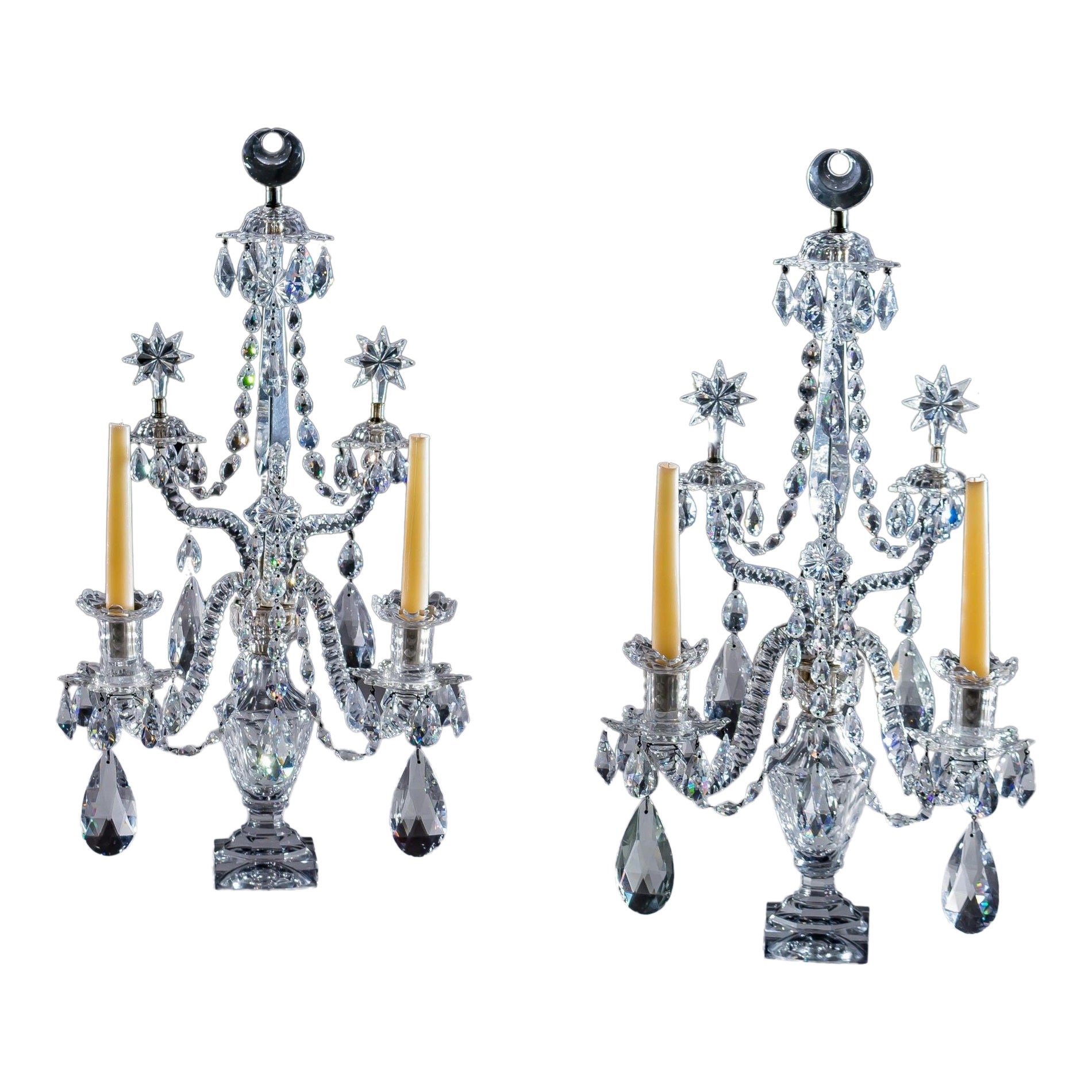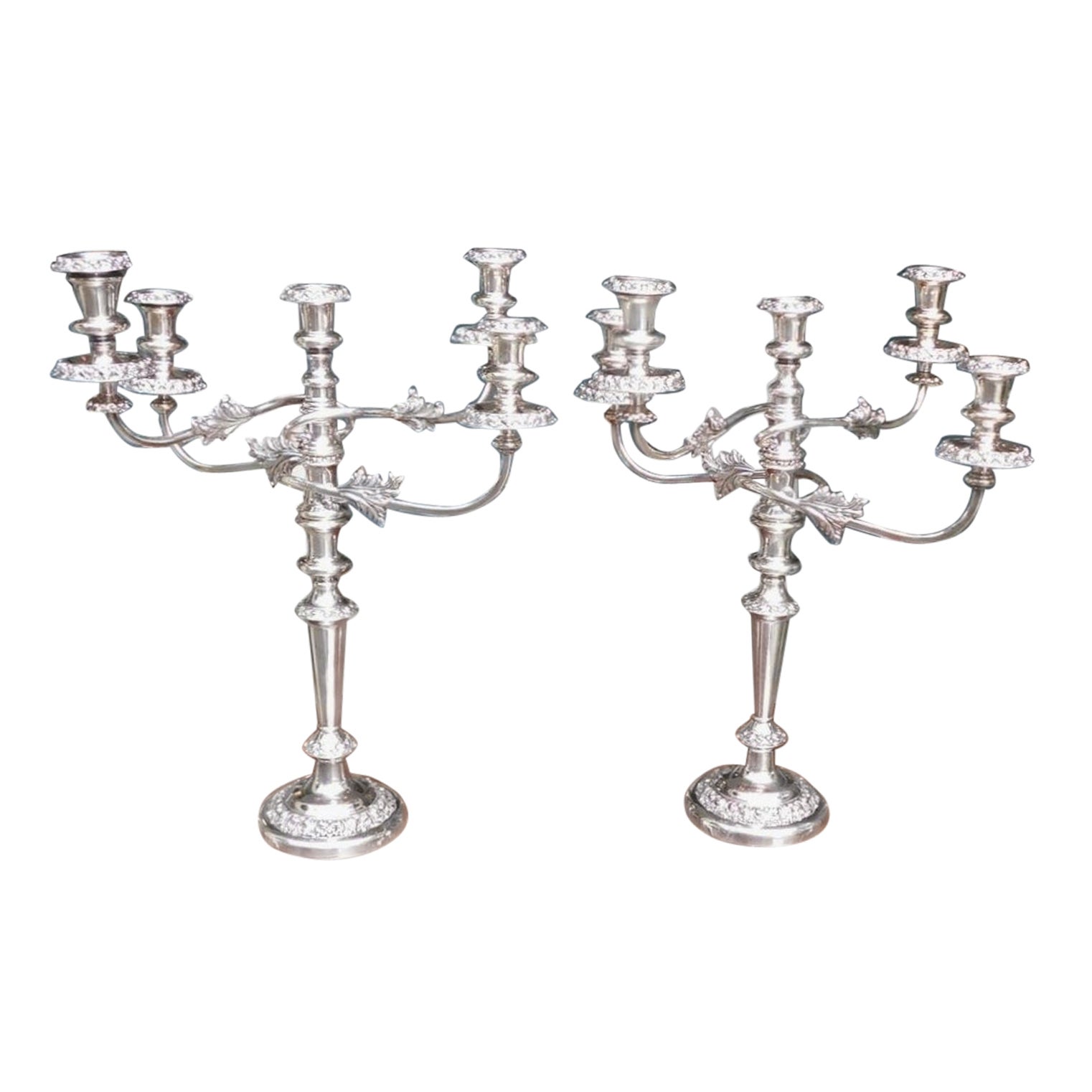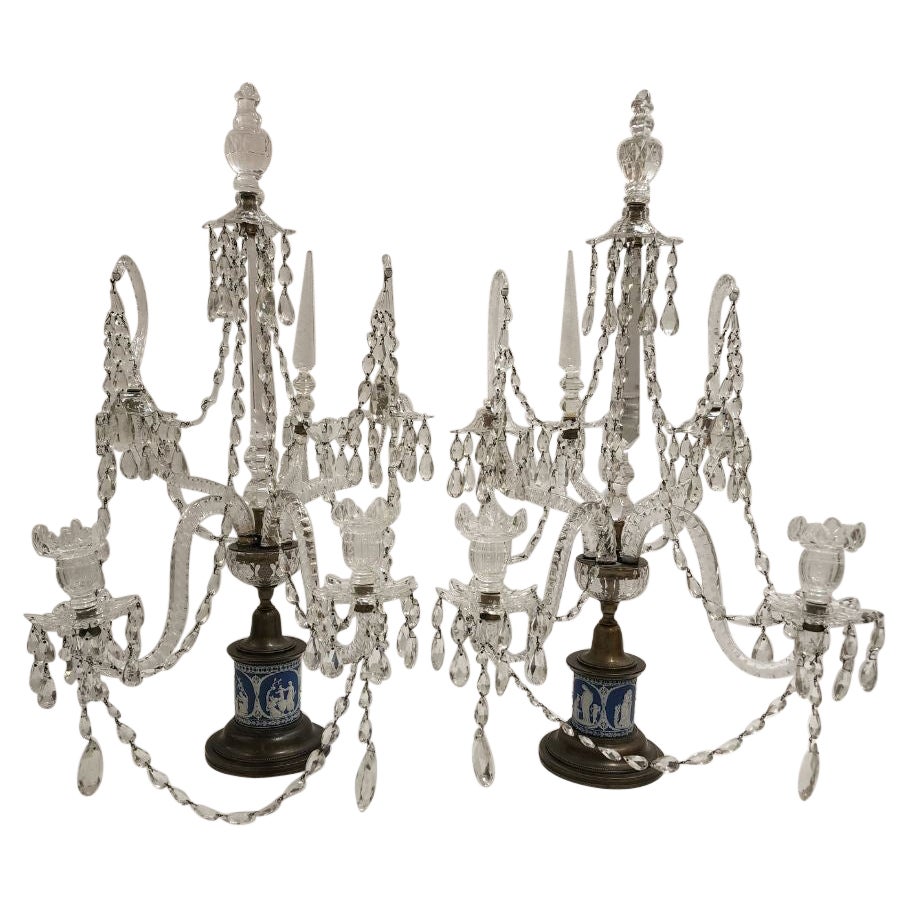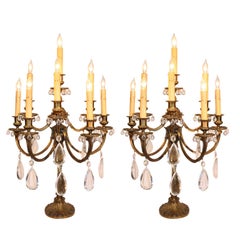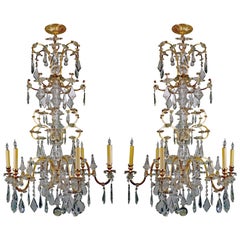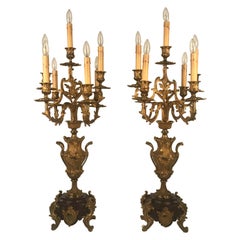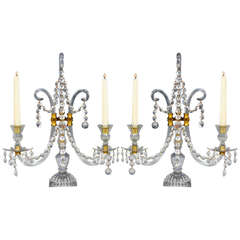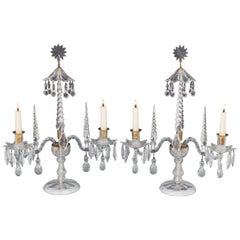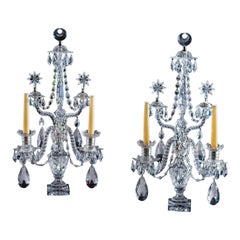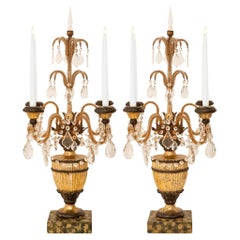Items Similar to English George III Period Pair of Candelabra, William Parker
Want more images or videos?
Request additional images or videos from the seller
1 of 16
English George III Period Pair of Candelabra, William Parker
$45,000per set
£33,987.44per set
€39,279.43per set
CA$63,119.39per set
A$70,194.87per set
CHF 36,743.78per set
MX$856,292.04per set
NOK 461,698.92per set
SEK 434,287.44per set
DKK 293,195.43per set
About the Item
An important pair of two light cut glass brass mounted George III candelabra attributed to the celebrated maker William Parker,
Each raised on a cut baluster and square base supporting two candle arms with hung drip pans and sconces, also with two complimenting arms terminating to canopied spires and centred by a large triangular spire supporting a canopy with an urn shaped finial, the whole beautifully draped with lustrous swags, pendants and drops all of the highest quality cut glass.
PROVENANCE: original bill of sale
M. Harris and Sons
Sold: Nov 2. 1945, 165 pounds sterling
Montréal estate by descent.
- Attributed to:William Parker (Maker)
- Dimensions:Height: 28 in (71.12 cm)Diameter: 16 in (40.64 cm)
- Sold As:Set of 2
- Style:Georgian (Of the Period)
- Materials and Techniques:
- Place of Origin:
- Period:
- Date of Manufacture:1780
- Condition:Replacements made: Note a fracture of one candle sconce, pair of finial urns museum quality replacements. Wear consistent with age and use.
- Seller Location:Montreal, CA
- Reference Number:Seller: D32001stDibs: LU875320290192
About the Seller
4.8
Gold Seller
Premium sellers maintaining a 4.3+ rating and 24-hour response times
Established in 1985
1stDibs seller since 2009
220 sales on 1stDibs
Typical response time: 2 hours
- ShippingRetrieving quote...Shipping from: Montreal, Canada
- Return Policy
Authenticity Guarantee
In the unlikely event there’s an issue with an item’s authenticity, contact us within 1 year for a full refund. DetailsMoney-Back Guarantee
If your item is not as described, is damaged in transit, or does not arrive, contact us within 7 days for a full refund. Details24-Hour Cancellation
You have a 24-hour grace period in which to reconsider your purchase, with no questions asked.Vetted Professional Sellers
Our world-class sellers must adhere to strict standards for service and quality, maintaining the integrity of our listings.Price-Match Guarantee
If you find that a seller listed the same item for a lower price elsewhere, we’ll match it.Trusted Global Delivery
Our best-in-class carrier network provides specialized shipping options worldwide, including custom delivery.More From This Seller
View AllPair of Victorian Silver Plated Four Light Candelabra
Located in Montreal, QC
While unmarked, these seem to us to be in the style of Elkington. The prevailing motif is fruiting vine, the stem, arms and drip pans continue the theme, the three legged base is als...
Category
Antique 19th Century English Victorian Candle Holders
Materials
Silver Plate
Pair of Antique French Louis XVI Style Bronze Eight-Light Candelabra
Located in Montreal, QC
They are unusual in form, each with curved shaft and mask decoration issuing seven curved candle arms, and topped with one candle arm, all hung with half...
Category
Antique 19th Century French Louis XVI Candle Holders
Materials
Bronze
Rare Pair of Large French 19th Century Chandeliers
Located in Montreal, QC
A rare pair of large French 19th century chandeliers. Each with six lights, the gilded shaped arms applied with opalescent beads, the central columns clad in shaped glass sleeves, th...
Category
Antique 1870s French Louis XVI Chandeliers and Pendants
Materials
Brass, Iron
$36,000 / set
Pair of Antique French Six Arm Candelabra, Bronze Dore on Rouge Marble Bases
Located in Montreal, QC
This pair, very much in the Louis XV style, has a number of points of interest : The six arms are arranged around the central light so there are actually seven lights, the vase shaped stem is modelled in bas-relief with leaves, and the base is a well-chosen shaped rouge griotte marble tablet...
Category
Antique Late 19th Century French Louis XV Table Lamps
Materials
Bronze
F&C Osler, a Pair of Lead Crystal Wall Sconces
By F. & C. Osler
Located in Montreal, QC
An unusual pair of three light late Victorian silvered mounted, cut glass candle sconce, stamped F&C OSLER. The arm plate supporting two s shaped ...
Category
Antique 1880s English George III Candle Sconces
Materials
Crystal
$8,500 / set
Pair of Impressive French Restauration Candelabra Mounted as Lamps
Located in Montreal, QC
Pair of impressive French Restauration candelabra, now mounted as lamps, each seven-light gilt and oxidized bronze candelabrum mounted on a Sienna marble column...
Category
Antique 19th Century French Restauration Candle Holders
Materials
Marble, Bronze
You May Also Like
Important Pair of English George III Period Candelabra by Lafount
Located in Steyning, West sussex
An important pair of English George III period cut-glass and brass-mounted two-light candelabra by Lafount, the candelabra supported by cut square bases with lemon squeezer inset below, the candle branches and central shepherd’s crook of ribbed section and of typical scrolling form, the branches supporting van dyke drip pans and thistle shaped candle nozzles, all draped with round double pointed spangles and finial drops, the mounts stamped LAFOUNT PATENT.
For similar pair of candelabra see plate 66, page 122; The English Glass Chandelier by Martin Mortimer (The Corning Museum of Glass) MOSES LAFOUNT Pleasant Row, Pentonville, in the county of Middlesex, lustre maker. On 19TH December 1796, Moses Lafount and Alexander Thomas and James Cox...
Category
Antique 18th Century and Earlier British Georgian Candle Holders
Materials
Ormolu
Rare Pair of George II English Cut-Glass Candelabra
Located in Steyning, West sussex
A rare pair of George II English cut-glass two-light candelabra attributed to Christopher Haedy the diamond-cut bases with baluster stem and all in one containers these centred by triangularly notched spires these surmounted by a drop hung step cut scallop edged canopy and a star cut finial the container plates supporting a notched cut snake arm and two slip over candle arms unusual mounted with triangularly spires these arms with star cut slip over drop hung drip pans. The candelabra hung with notched cut kite shaped drops and lapidary cut wasted ball drops all if the finest quality.
For similar candelabra see The English Glass Chandelier...
Category
Antique 1760s English George II Candelabras
Materials
Cut Glass
$33,060 / set
A Pair Of George Iii Cut Glass Candelabra By William Parker
By William Parker
Located in Steyning, West sussex
The square concave bases of urn form, mounted with diamond cut containers issuing four notch cut arms, two of scroll form supporting drip pans and candle save all's, a further two mo...
Category
Antique 18th Century English George III Candelabras
Materials
Cut Glass
Pair of Italian 19th Century Louis XVI St. Candelabras
Located in West Palm Beach, FL
A sensational and most decorative pair of Italian 19th century Louis XVI st. Mecca, Glass and Faux Painted Marble candelabras. Each stunning four arm candelabra is raised on a square faux painted marble base below the urn shaped body. The Mecca and patinated black urn supports the 'S' scrolled beaded arms which are joined by Glass swaging...
Category
Antique 19th Century Italian Louis XVI Candelabras
Materials
Wood
Pair of English Regency Sheffield Candelabras, Matthew Boulton, Circa 1800
By Mathew Bolton
Located in Charleston, SC
A complete pair of English Regency Sheffield five-light candelabras with removable intertwined scrolled arms, original hand chased removable foliage motif bobeches, bulbous floral tapered columns, and resting on foliage motif circular bases. Candelabra bobeches...
Category
Antique Early 1800s English Regency Candelabras
Materials
Sheffield Plate, Copper
Pair of English bronze and Wedgewood Candelabra
Located in Dallas, TX
English Wedgewood candelabra 19th century
Crystal
Measures: 30'H 16'W 16'D.
Category
Antique 17th Century Table Lamps
Materials
Crystal, Bronze
$20,000 Sale Price / set
20% Off
More Ways To Browse
Glass Candelabra
Candelabra Sconce
Candelabra Pendants
Candelabra Crystal
Candle Pendant Light
Pair Crystal Candelabra
Large Brass Candelabra
Antique Brass Candelabra
Cut Glass Candelabra
Cut Crystal Candelabra
Antique Candelabra With Crystals
Sterling Candelabra Pair
Glass Spires
Brass Square Candle
Cut Glass Urn
Swag Cut Glass
18th Century Canopy
Two Light Pendant Antique Brass
